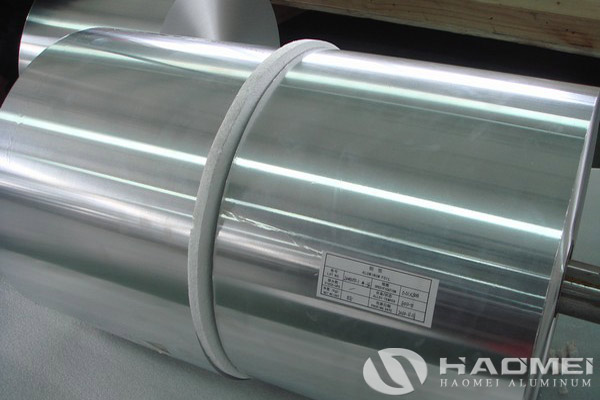The aluminum foil fin stock for condensers is a very critical part of the heat exchanger, and its main purpose is to improve the heat exchange efficiency. This type of aluminum foil fin stock is usually made of high-purity aluminum alloy to ensure good thermal conductivity and mechanical strength. 8011 and 8006 are two aluminum alloy materials commonly used to make condenser aluminum foil fins.
The aluminum foil fin stock used for condensers mainly include the following types, each with its own characteristics:
- Bare aluminum foil
Plain bare aluminum foil has not undergone special surface treatment, and the cost is low, but the corrosion resistance and hydrophilicity are poor. Long-term use is easy to oxidize and powder, and the condensed water is difficult to distribute evenly, which may form a “water bridge”, increase wind resistance and reduce heat exchange efficiency.

- Hydrophilic aluminum foil
The surface of aluminum foil for condenser fins is coated with a hydrophilic coating (such as a resin film or an inorganic material), which has the following advantages:
– Hydrophilicity: Condensed water can evenly infiltrate the surface, reduce the formation of water bridges, reduce ventilation resistance, and improve heat exchange efficiency.
– Corrosion resistance: The coating can resist environmental erosion such as acid mist and salt, and extend the service life.
– Compatibility: Suitable for a variety of refrigerants (such as R22, R134A, etc.).

- Organic pre-coated aluminum foil
Using organic resin coating, compared with inorganic pre-coated aluminum foil (such as water glass coating), its advantages include:
– Stronger corrosion resistance: The surface is neutral or weakly acidic, avoiding the problem of blackening of copper tubes.
– Excellent processing performance: The coating has little wear on the mold and better bending formability.
- 8011 aluminum alloy foil
A high-performance air conditioner aluminum foil material, widely used in air-conditioning condensers and evaporators:
– Excellent thermal conductivity: Rapid heat conduction, improving refrigeration efficiency.
– Corrosion resistance: After oxidation, a dense oxide film is formed to resist refrigerant and environmental corrosion.
– Lightweight and processability: Low density, easy to bend and form, suitable for complex fin design.
- Anodized aluminum foil
-The oxide layer is generated on the aluminum surface through the anodizing process, which significantly improves:
– Corrosion resistance: Suitable for humid or corrosive environments.
– Surface hardness: Reduce physical damage during transportation or use.
- Composite flux coated aluminum foil
The outer side of the aluminum foil is coated with composite flux, and no additional brazing process is required when welding with the flat tube. The advantages include:
– Simplified process: reducing production steps and reducing costs.
– High connection strength: the annular bottom and the flat tube are welded more tightly, which improves the life of the heat exchanger.
The selection of aluminum foil fin stock for condensers needs to comprehensively consider heat transfer efficiency, corrosion resistance, cost and processing technology. Hydrophilic aluminum foil and 8011 aluminum foil have become the mainstream choice due to their excellent comprehensive performance; organic pre-coated and composite flux coated aluminum foil have more advantages under specific process requirements. In the future, with the improvement of energy-saving and environmental protection requirements, the application of high-performance coated aluminum foil will be further expanded.
